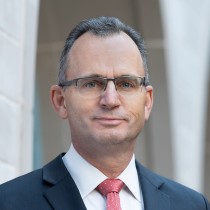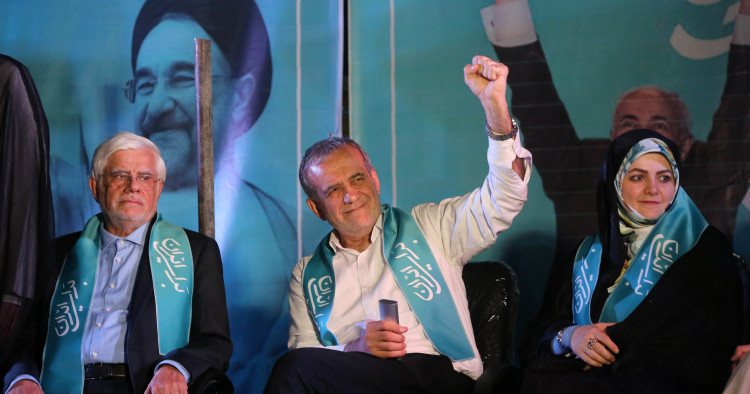Contents:
- How significant is "reformist" candidate Pezeshkian’s victory in Iran’s presidential vote?
- Key Mideast leaders should engage directly with the new Iranian president
- Evolution of Israel-Hezbollah conflict hinges on outcome of Gaza talks
- New diplomacy and mixed signals on a cease-fire and hostage deal in the Israel-Hamas war
- Don’t expect big decisions vis-à-vis NATO’s eastern or southern flanks at this week’s Washington Summit
- Despite Labour’s landslide victory in UK elections, little is likely to change on MENA policy
How significant is “reformist” candidate Pezeshkian’s victory in Iran’s presidential vote?
Marjan Keypour
Non-Resident Scholar

-
While Masoud Pezeshkian won 53.6% of the vote overall, three provinces — East Azerbaijan, West Azerbaijan, and Ardebil — accounted for the overwhelming majority of his margin of victory, contradicting any notion of a widespread reformist revival.
-
Pezeshkian’s election is unlikely to bring about significant domestic changes as key issues, like Iran’s long-standing economic problems and the compulsory hijab rule, reflect the regime’s priorities; there may be a glimmer of opportunity for Western nations interested in potential diplomatic engagement with Tehran though.
Iran’s presidential elections ended with heart surgeon and moderate “reformist” Masoud Pezeshkian winning by a margin of 3 million votes against hardliner Saeed Jalili. The elections were called to replace President Ebrahim Raisi, who died in a mysterious helicopter crash in late May. The July 5 runoff followed a first-round vote on June 28 with record low turnout and inconclusive results.
Voter turnout was a crucial issue for Supreme Leader Ali Khamenei, who time and again pleaded with Iranians to reconcile their differences with the government by participating in the elections.
The results were still dismal. According to official numbers, which tend to be inflated, 30.5 million ballots (including over 600,000 voided ones) were cast, representing a participation rate of 49.8%. Citizen journalists documented empty voting places throughout the day, substantiating the weak turnout. The low participation rate is effectively the silent majority’s referendum on Khamenei and rejection of the regime. More than half of eligible voters chose not to participate at all, disengaging from an electoral process that they dismissed as a “circus.”
The official numbers reveal important contradictions in the state of the reform movement. While Pezeshkian won 53.6% of the votes overall, against Jalili’s 44.3%, a closer examination of the results by province shows that Pezeskhian’s victory was neither a straightforward landslide, nor an indication of a revival of the reform movement. Competition between the two candidates was marginal in most provinces, suggesting limited enthusiasm, if any, for reform. Pezeshkian’s decisive wins were concentrated in Iran’s East Azerbaijan, West Azerbaijan, and Ardebil provinces, where ethnic Azeris sharing a heritage with Pezeshkian and Ayatollah Khamenei are prominent. These three provinces accounted for the overwhelming majority of Pezeshkian’s margin of victory — 2.7 million out of a total of 3 million votes — contradicting any notion of a widespread revival of the reformist movement across the country.
Pezeshkian’s election is unlikely to bring about significant domestic change. Iran’s long-standing economic problems and pervasive poverty hinge on the regime’s priorities, which have historically favored proxies and foreign interests over the needs of its own citizens. His pledges to ease enforcement of the compulsory hijab rule and improve internet access are likely to be thwarted by the supreme leader, who views hijab as fundamental to Islamic values and may opt to “solve” the internet problem by accelerating plans to nationalize the internet, yielding opposite outcomes. If past performance is anything to go by, the presidency of Hassan Rouhani (2013-21) should serve as a warning on human rights. In fact, the United Nations’ Special Rapporteur for the Islamic Republic Javaid Rehman has already warned that the situation is unlikely to improve much during Pezeshkian’s tenure.
Internationally, the election of a “reform” candidate, despite the limited promise of change, does offer a glimmer of opportunity for Western governments interested in diplomatic engagement with Iran. This potential diplomatic avenue is especially important given speculation about President Donald Trump’s return to the White House, allowing Iran to leverage historical divisions between European countries and Trump. Pezeshkian, with minimal foreign policy experience, is likely to defer to Khamenei, who swiftly reaffirmed his control over Iran’s leadership following the election by “praising” leaders like Raisi who follow authority.
Despite the labels attributed to them, Pezeshkian and Jalili ultimately represent the same party: the authority of Supreme Leader Khamenei, who makes all the decisions that matter in the Islamic Republic. While the notion of partisanship within Iranian politics might resonate with Western observers, for the Iranian people that’s long since ceased to be the case — and no amount of reform-branded candidates, electoral victories, or incremental changes can resuscitate it.
Follow: @MarjanKG
Key Mideast leaders should engage directly with the new Iranian president
Paul Salem
Vice President for International Engagement

-
The election of the reform-backed candidate Masoud Pezeshkian to the Iranian presidency represents a potential opening toward — limited but still significant — changes in Tehran’s regional and international foreign policy.
-
By voting for Pezeshkian or boycotting the election altogether, millions of Iranians voiced their strong dissatisfaction with the status quo and their desire for significant change; regional leaders should encourage the new Iranian president to pursue that change.
While ultimate power in Iran still resides with Supreme Leader Ayatollah Ali Khamenei, the election of the reform-backed candidate, Masoud Pezeshkian, to the presidency represents a potential opening toward — limited but still significant — changes in Tehran’s regional and international foreign policy. At a time when the United States is mired in its own dysfunctional and highly polarized election campaign, it is important that key Middle East leaders engage directly with the new Iranian president and encourage change in ways that he has already suggested in his statements.
Upon winning the presidency, Pezeshkian announced, “I have come … to seek lasting peace and tranquility and cooperation in the region, as well as dialogue and constructive interaction with the world.” He clearly wants to build on the de-escalation and improvement of relations with erstwhile rivals on the Arab side of the Gulf, and it is clear that he also wants to revive talks related to the 2015 nuclear deal as well as explore membership in the Financial Action Task Force. The response to his election from Hezbollah and other regional militias aligned with the Islamic Revolutionary Guard Corps (IRGC) was decidedly muted; they definitely do not want Iran to go in the direction that he is promising.
Although the bulk of regime power remains with the supreme leader and — in regional affairs — with the IRGC, Pezeshkian carries with him the force of public opinion. The 16.3 million Iranians who voted for him, and presumably the majority of the roughly 35 million who boycotted the vote altogether, voiced their strong dissatisfaction with the status quo and their desire for significant change. Regional leaders should encourage the new Iranian president to pursue that change.
Saudi Arabia is the key player on the Arab side of the Gulf, and pursuing something similar to its own program of rapid socio-economic change might be more than Pezeshkian can manage in Iran, but a summit soon between President Pezeshkian and the crown prince of Saudi Arabia could suggest a new opening in regional relations and send a strong and positive signal to the Iranian public that a different and better path forward is possible. Obviously, other regional players like the United Arab Emirates, Egypt, Qatar, and Turkey would also have roles to play. The challenge there is to make sure that these regional powers don’t get in each other’s way as a result of their own rivalries.
This regional role is particularly important at a time when the US is mired in its own internal dysfunctions. The Biden administration might be too weakened and distracted, and have too little time, to move on this potential opportunity; and a Trump administration, if the former president wins the November elections, will come in with a lot of bluster of its own.
Seemingly minor moments in history sometimes hint at the possibility of deeper change. Pezeshkian’s election might be such a moment. Middle Eastern leaders who are committed to a more peaceful and integrated region should test this possibility, engage with the new Iranian leadership, and encourage Iran toward a more rational and more regionally and globally integrated foreign policy. The bet might come up empty, but it’s worth trying.
Follow: @paul_salem
Evolution of Israel-Hezbollah conflict hinges on outcome of Gaza talks
Randa Slim
Senior Fellow and Director of Conflict Resolution and Track II Dialogues Program

-
There are expectations that an Israeli-Hamas cease-fire deal will result in Hezbollah stopping its own attacks against Israel.
-
But Hezbollah is unlikely to back down if the Gaza war persists and Israeli forces do not withdraw or if Israel continues its campaign of assassinating high-level Hezbollah commanders in Lebanon.
The ongoing indirect negotiations between Israel and Hamas for a cease-fire and the release of Israeli hostages and Palestinian prisoners seem to be heading in a positive direction. This could be a hopeful development to help restrain the escalating conflict brewing along the Israeli-Lebanese border.
Months of indirect talks between the two belligerents in the Gaza war have stumbled over Hamas’ demand that any final deal includes Israel’s commitment to a permanent cease-fire and full withdrawal of Israeli forces from the Gaza Strip — a commitment Israeli Prime Minister Benjamin Netanyahu has, to date, refused to make. According to recent media reports, the unblocking of the stalemated negotiation process happened as a result of Hamas accepting guarantees from the three mediators, the United States, Qatar, and Egypt, that a temporary cease-fire will stay in place as the negotiations for a permanent cease-fire deal proceed.
An Israeli delegation is scheduled to visit Doha this week to discuss the details of the agreement with senior US, Qatari, and Egyptian officials. The shift in Hamas’ position is no guarantee that a deal will ultimately be reached at this juncture, however. It is not clear if the Israeli prime minister is interested in agreeing to any sort of arrangement and halting the war on Gaza yet. The ball is in his court.
In Lebanon, the expectation is that once Israel and Hamas reach an agreement in Doha on a cessation of hostilities, Hezbollah’s own cross-border strikes into Israeli territory will “stop without any discussion,” as was the case last November, when a temporary cease-fire paused the Gaza war. However, there are two future scenarios that might emerge in the military theaters in Gaza and on the Israel-Lebanon border over which Hezbollah has yet to clarify its position.
First, what position will Hezbollah take if there is neither a permanent cease-fire agreement nor a full withdrawal of Israeli forces from Gaza? Hezbollah’s Deputy Secretary-General Sheikh Naim Kassem said in an interview on June 2 that “if what happens in Gaza is a mix between cease-fire and no cease-fire, war and no war, we can’t answer now, because we don’t know its shape, its results, and its impacts.” This statement could have been read as an attempt by Hezbollah to delink the Gaza and Israel-Lebanon fronts; but Nasrallah’s July 7 speech confirming the unbending commitment to continue the group’s war of support of Gaza clarifies somewhat its position on this subject.
Second, how will Hezbollah respond if Israel decides to continue its campaign inside Lebanon of targeted assassinations of Hezbollah commanders? Irrespective of ongoing negotiations in Gaza, Hezbollah’s response in that scenario will almost certainly be similar to what has unfolded to date, whenever one of the group’s key personnel was assassinated.
Both Israel and Hezbollah continue to be averse to an all-out war between them. Each side is interested in the return of its displaced constituents to their communities in northern Israel and southern Lebanon, respectively. This bodes well for the restoration of some form of pre-Oct. 8 “mutual deterrence” status quo on the Lebanon-Israel border.
Achieving a new permanent status quo on the Lebanese-Israeli border will be linked to two factors. The first is the success or failure of a permanent cease-fire deal between Israel and Hamas. A permanent cease-fire in Gaza would pave the way for renewed negotiations between Israel and Lebanon on new border arrangements, including the settlement of outstanding land disputes. The second deciding factor is whether or not the international community, led by the United States and France, continues to engage and push for negotiations on a new political framework defining fresh rules of engagement between Israel and Hezbollah. It is unlikely that this diplomatic process will result in a full implementation of United Nations Security Resolution (UNSC) 1701, which was reached in 2006, following the previous war between Israel and Hezbollah. New conditions on the ground and regionally demand new arrangements. However, it is likely that a new set of arrangements that fall short of UNSCR 1701 can be agreed upon, as long as they provide enough guarantees to address security concerns of both sides and institute a long period of calm on the Lebanon-Israel border.
Follow: @rmslim
New diplomacy and mixed signals on a cease-fire and hostage deal in the Israel-Hamas war
Brian Katulis
Senior Fellow for US Foreign Policy

-
Media outlets report on possible shifts and new openings as American, Arab, and Israeli officials continue to work to find a pathway to a Gaza war cease-fire deal and hostage release.
-
Israel’s Prime Minister Benjamin Netanyahu continues to face strong pressures at home, with protestors calling for a deal and key members of his government rejecting one.
US President Joe Biden spotlighted one notable aspect of his Middle East policy in his interview with ABC News anchor George Stephanopoulos on Friday. Early in the interview, which Biden did to dispel strong concerns about his debate performance against Donald Trump late last month, Stephanopoulos asked him, “Are you the same man today that you were when you took office three-and-a-half years ago?”
Biden’s first and initial response was to point to a deal he proposed on ending the Israel-Gaza war in late May, but which has not yet come to fruition: “In terms of successes, yes [I am the same man when I took office]. I also was the guy who put together a peace plan for the Middle East that may be comin’ to fruition.” It was a curious choice given that American voters’ perceptions about how Biden has handled the Israel-Hamas war are strongly negative, with nearly two-thirds disapproving of Biden’s response to the conflict in Gaza.
Biden’s statement came at a time when there has been renewed diplomatic activity to secure a cease-fire and release of hostages. An Israeli team, led by the Mossad, held another round of talks on a possible deal last week, and US Central Intelligence Agency (CIA) Director Bill Burns reportedly is traveling to Doha this week, following a stop in Cairo, to try to achieve progress in these talks in discussions with Israeli, Qatari, and Egyptian officials.
The central conundrum that has plagued any progress on a cease-fire remains: the two main combatants have more of an interest in keeping the fighting going in an effort to stay in power, and neither side fully accepts the others’ legitimacy. One continued sticking point has bedeviled these negotiations since the last and only cease-fire in this war collapsed in December: Hamas wants stronger assurances that the fighting would end with this new cease-fire, but Israel’s current government is not willing to offer that guarantee.
Inside of Israel, protesters have continued to put pressure on Prime Minister Benjamin Netanyahu to secure a cease-fire and hostage release. In turn, some right-wing ministers in Netanhayu’s government unwaveringly oppose a deal, while Netanyahu continues to assert Israel’s right to defend itself against threats even after a possible agreed-to pause in the fighting. There are reports that many in Israel’s military leadership want a deal because munitions are running low and tensions remain strong on Israel’s northern border. At the same time, the Hamas leadership allegedly remains intact and its capacity to conduct attacks against Israel persists. Given these factors, questions of how this war ends and what comes after it remain unanswered.
Netanyahu is planning to come to Washington, DC, in two weeks; while, at home, he faces growing perceptions that he has gotten his country into a quagmire with no end in sight. This next phase could prove to be a key period defining what comes next. Much can happen in these two weeks on other fronts, with growing questions about Biden’s candidacy for re-election and a North Atlantic Treaty Organization (NATO) summit in Washington this week to give just two examples.
The three-phase plan the US president announced in late May for a cease-fire and a bridge to a more comprehensive settlement seems to be the gameplan the Biden administration is operating with. This coming week will offer some signs on whether Biden had good reason to tout a proposed Middle East peace plan as a key indicator for his fitness to stay in office.
Follow: @Katulis
Don’t expect big decisions vis-à-vis NATO’s eastern or southern flanks at this week’s Washington Summit
Iulia-Sabina Joja
Director, Black Sea Program

-
The Biden administration has designed this week’s NATO summit in Washington to highlight allied unity and solidarity during challenging times; it will not be a major agenda-setting meeting.
-
Although NATO countries today face arguably some of the largest threats in the Alliance’s history, the Washington Summit is unlikely to reassert long-term deterrence or provide for a more certain future in the Black Sea region or the southern neighborhood.
The North Atlantic Treaty Organization’s (NATO) Washington Summit on July 9-11 will be more of a celebration, marking 75 years of the Alliance, rather than an agenda-setting meeting of Allies. The Biden administration has designed the summit to bring Transatlantic leaders together to highlight allied unity and solidarity during challenging times. The two sides of the recently enlarged democratic North Atlantic family — led by a US president who may go down in history as America’s last Transatlanticist — are coming together a few months before the most consequential election facing the United States in decades. Uncertainty is looming not just regarding future US policy toward NATO but also for the Alliance overall. European leaders are voicing ample concern about President Joe Biden’s candidacy but even more so about the possibility of Donald Trump’s return to the White House. Trump’s preoccupation with Europeans not doing enough for their defense and his promise to end the Russo-Ukrainian war in 24 hours are casting a pall over those expected Transatlantic celebrations this week.
The largest war on the European continent in 70 years continues to rage in Ukraine, with no end in sight. NATO membership for Kyiv doesn’t seem to be on the table for this summit. NATO leaders have also failed to adopt a strategy for ending the war, collectively limiting themselves to vague slogans of supporting Ukraine “as long as it takes.” That is unlikely to change after this week. Europeans and Americans have been scrambling to ensure a steady flow of ammunition and equipment to prevent Russia from advancing deeper into Ukraine and destroying more critical infrastructure. Yet last night, Russia bombed Ukraine’s largest children’s hospital. Despite the war topping the Washington Summit’s agenda, no one expects the gathered heads of state and government to agree upon a clear outcome for the war or develop a strategy to stabilize the wider Black Sea region.
In the east, NATO remains very popular, but allied leaders continue to withhold membership in the places where the Alliance is most wanted — Ukraine, Georgia, and beyond. In the south, on the other hand, NATO is vastly unpopular as a manifestation of what is seen as a vacillating or hypocritical West. NATO is preparing a Southern Strategy for the Middle East and beyond, but this strategy is unsurprisingly unambitious. The war in Gaza overshadows the Russian invasion of Ukraine for countries south of Europe, but the Alliance is bound to a modest footprint and level of ambition in its southern neighborhood. The largest challenge for NATO will be integrating deterrence and defense to hold the growing coalition of anti-Western forces at bay — the Sino-Russian-Iranian-North Korean-Belarusian cooperation formats. NATO Allies face a spectrum of hybrid threats in the contemporary era of great power competition and asymmetric warfare. Iranian-made Russian-launched drones are exploding on NATO territory in Romania, while China and Belarus just announced “anti-terror” exercises. And the Belarusian security services, in coordination with their Russian counterparts, continue to direct waves of migrants from the Middle East to the border with Poland, a NATO member. NATO countries today face arguably some of the largest threats in the Alliance’s history, but this week’s Washington Summit is unlikely to reassert long-term deterrence or provide for a more certain future.
Follow: @IuliJo
Despite Labour’s landslide victory in UK elections, little is likely to change on MENA policy
Charles Lister
Senior Fellow, Director of Syria and Countering Terrorism & Extremism programs

-
While domestic challenges dominated Labour’s election agenda, foreign policy is likely to come to the fore fairly quickly, although the Middle East remains comparatively low on the priority list and the status quo will be the overriding rule.
-
Ultimately, the Labour government will be keen to reintegrate itself into the European consensus and double down on the special relationship with Washington, aligning its foreign policies with the US and Europe.
After 14 years of Conservative government, the United Kingdom’s general election on July 4 witnessed an almost unprecedented landslide, bringing the Labour Party to power and moving its leader, Keir Starmer, to 10 Downing Street as prime minister. The allocation of seats in Parliament illustrated a dramatic shift in political dynamics, with Labour now holding 63% of seats compared to 19% for the Conservatives.
However, the UK’s “first past the post” electoral system concealed a more complex reality, as Labour only won 34% of the vote, with the Conservatives at 24%. Overall turnout was also the second lowest in more than a century. Taken together, the Conservative and Labour parties secured the lowest vote share ever, making the potential influence of the new right-wing Reform Party (14% of votes; 1% of seats) and the traditionally smaller Green Party (7% of votes; 1% of seats) and Liberal Democrats (12% of votes; 11% of seats) far greater than is normally the case.
The election also illustrated how foreign policy issues can influence voting, with the war in Gaza triggering major upsets. Five Labour parliamentarians in constituencies with very large and long-standing majorities were defeated by independents who ran on Gaza-oriented agendas opposed to Starmer’s supportive stance toward Israel, which at times was markedly stronger than that of the Conservatives on the other side of the aisle. Nationwide, in seats where Muslims represented at least 25% of voters, Labour’s vote share plummeted by 23%.
Labour’s manifesto offered little in the way of clues about Middle East policy or foreign policy writ large. After all, the party’s foreign policy circles embrace positions that are almost identical to those of their Conservative counterparts. Though domestic challenges dominated Labour’s election agenda, foreign policy is likely to come to the fore fairly quickly. Prime Minister Starmer and Foreign Secretary David Lammy will be in Washington this week attending the North Atlantic Treaty Organization (NATO) Summit; the UK is hosting as many as 50 European governments at Blenheim Palace on July 18 for the European Political Community meeting; and major gatherings of the United Nations (September), Commonwealth (October), and the G20 (November) are all approaching. Notably, within 48 hours of assuming his role as defense secretary, John Healey was already in Ukraine.
At the same time, there are few clear alternatives to the UK’s current foreign policy path, and Middle East issues remain comparatively low on the priority list. Status quo will be the overriding rule. Israel and Gaza are where the most challenges lies. Starmer is a strong defender of Israel, but Foreign Secretary Lammy has more of a history on the left of the party, where the Palestinian quest for statehood has strong support. Nevertheless, in recent weeks, Lammy’s positions on the issue have been clear, and unremarkable: an immediate cease-fire, release of all hostages, unfettered aid access in Gaza, and a two-state solution. He has, however, publicly endorsed the International Criminal Court’s call for an arrest warrant for Israeli Prime Minister Benjamin Netanyahu, a position unlikely to align with Starmer’s. Lammy is also likely to push for a renewal of funding for the United Nations Relief and Works Agency for Palestine Refugees in the Near East (UNRWA), and he has signaled an openness to designating Iran’s Islamic Revolutionary Guard Corps as a terrorist organization.
Ultimately, this is a Labour government that will be keen to reintegrate itself into the European consensus and double down on the special relationship with Washington, aligning its foreign policies with the US and Europe. Starmer and especially Lammy will look to use this week’s NATO Summit as an opportunity to build a strong relationship with the Biden administration, offering to collaborate on issues like Ukraine, Gaza, and China, while possibly upping the UK’s defense budget from 2.3% of GDP to 2.5%.
On the other hand, with the US election up in the air, bridging ties with the Donald Trump campaign will also be a priority — particularly after Lammy’s 2018 comments labeling Trump a “woman hating, neo-Nazi-sympathizing sociopath” who posed a “profound threat to the international order.” Lammy was in the US in May on a trip widely suspected to have been more about engaging Republicans than Democrats.
Follow: @Charles_Lister
Photo by Fatemeh Bahrami/Anadolu via Getty Images
The Middle East Institute (MEI) is an independent, non-partisan, non-for-profit, educational organization. It does not engage in advocacy and its scholars’ opinions are their own. MEI welcomes financial donations, but retains sole editorial control over its work and its publications reflect only the authors’ views. For a listing of MEI donors, please click here.













